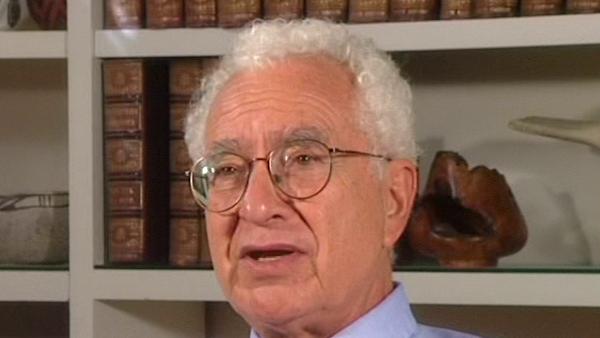NEXT STORY

Quantum field theory on the mass shell
RELATED STORIES

NEXT STORY

Quantum field theory on the mass shell
RELATED STORIES


|
Views | Duration | |
|---|---|---|---|
| 41. Learning about theory | 1796 | 01:02 | |
| 42. We never wrote up the crossing relations | 1237 | 02:24 | |
| 43. Quantum field theory on the mass shell | 1474 | 02:39 | |
| 44. Geoff Chew and mass shell field theory | 1274 | 00:47 | |
| 45. 1961 La Jolla meeting: taking Oppenheimer to lunch | 1588 | 02:02 | |
| 46. 1961 La Jolla meeting: Geoffrey Chew | 1404 | 01:45 | |
| 47. Stanley Mandelstam | 1621 | 01:11 | |
| 48. The bootstrap theory | 1578 | 02:20 | |
| 49. The assistant professorship at Chicago | 1174 | 02:53 | |
| 50. Working on the renormalization group with Francis Low | 1430 | 01:20 |


Murph and I did a variety of things. One was we noticed the crossing relations, coming from the fact that diagrams would always have symmetry between crossed and uncrossed lines. And that gave rise to a symmetry in the relativistic scattering amplitudes in which one interchanged positive and negative momenta and so on and so forth, as you know. So these crossing relations we discovered, we never really wrote them up. We referred to them in various things that we wrote, but we never actually wrote them up as a discovery. Another example of this business of not taking important things seriously, if… if we had done them or if I had done them. Now of course the old-timers in quantum mechanics knew about such as symmetry vaguely. It was a kind of folk theorem. They never wrote it down either, and they never used it for anything much, but they did know that there was such a thing, even in the old-fashioned form of quantum field theory. Another thing we did then was to look at forward scattering amplitudes for massless particles, say a photon, so, forward photon scattering, and return to the old work on dispersion relations which had given rise to quantum mechanics in the work of Kramers, Heisenberg, Born and so on, in 1924–just before quantum mechanics. And we showed that there were these forward scattering dispersion relations. We found a new one for spin flip with the opposite crossing symmetry, and then later on Murph and some collaborators showed that there were these relations even when you didn't have a massless particle like the photon. And then Polkinghorne and I, and a great number of other people, showed that you would have them also for non-forward scattering, for fixed momentum transfer. That was very exciting because all of this work was on the mass shell.
New York-born physicist Murray Gell-Mann (1929-2019) was known for his creation of the eightfold way, an ordering system for subatomic particles, comparable to the periodic table. His discovery of the omega-minus particle filled a gap in the system, brought the theory wide acceptance and led to Gell-Mann's winning the Nobel Prize in Physics in 1969.
Title: We never wrote up the crossing relations
Listeners: Geoffrey West
Geoffrey West is a Staff Member, Fellow, and Program Manager for High Energy Physics at Los Alamos National Laboratory. He is also a member of The Santa Fe Institute. He is a native of England and was educated at Cambridge University (B.A. 1961). He received his Ph.D. from Stanford University in 1966 followed by post-doctoral appointments at Cornell and Harvard Universities. He returned to Stanford as a faculty member in 1970. He left to build and lead the Theoretical High Energy Physics Group at Los Alamos. He has numerous scientific publications including the editing of three books. His primary interest has been in fundamental questions in Physics, especially those concerning the elementary particles and their interactions. His long-term fascination in general scaling phenomena grew out of his work on scaling in quantum chromodynamics and the unification of all forces of nature. In 1996 this evolved into the highly productive collaboration with James Brown and Brian Enquist on the origin of allometric scaling laws in biology and the development of realistic quantitative models that analyse the influence of size on the structural and functional design of organisms.
Tags: Murph Goldberger, Hans Kramers, Werner Heisenberg, Max Born, John Polkinhorne
Duration: 2 minutes, 25 seconds
Date story recorded: October 1997
Date story went live: 24 January 2008